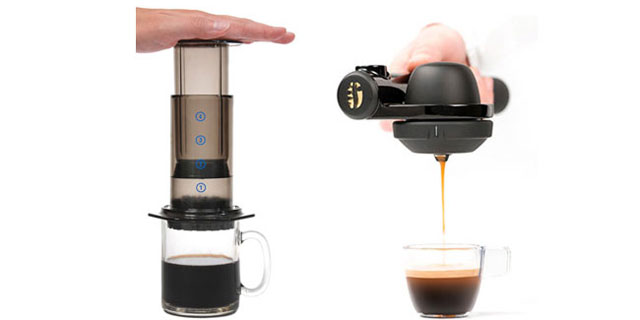If there is one thing I cannot abide when I’m traveling, it’s bad coffee. And sadly, there’s so much of it. Airplane coffee is tasteless. Hotel coffee is weak. And who knows if those carafes are ever really cleaned? Hotel housekeepers interviewed for a recent travel magazine article about room cleaning secrets said they wipe down coffee makers and cups with Pledge. So that’s what that taste is….
Earlier this summer, I decided that something had to give. With several back-to-back trips ahead of me, I couldn’t stomach the idea of a month of bad coffee, so I started researching portable coffee makers. Two brands kept coming up: Handpresso and AeroPress . I ordered one of each and started testing.
The Handpresso (Wild Hybrid model, 99 euro) came with me on a trip to South Carolina. I sat at my mother’s kitchen table and read the directions to my husband, who is always charged with the task of figuring out gadgets. The device looked straightforward enough, but the sleek, handheld espresso maker was surprisingly challenging to work.
We finally did figure out the mechanics, which involve pumping to produce pressure (one of 16 steps depicted in drawings and accompanying captions), but the results were disappointing. The quantity of espresso the Handpresso produced was quite small and our first espresso was incredibly weak. The directions mentioned that it might take some refining to figure out the perfect texture of coffee to produce the desired strength of espresso, so we put our beans through the grinder a second time and made sure they were ultra-fine.
The second cup of espresso was definitely better, but overall, the result was still underwhelming. (Note: Handpresso does offer the option of using ESE pods, which can be ordered through their website; we did not try these in our testing of the device). You’d likely need to repeat the 16-step process at least four times if you wanted to produce enough espresso for two people to drink.
The Handpresso had more parts than I expected and this particular model doesn’t come with a carrying case, so in short order, we’d misplaced the filter for the machine, which is crucial to its functioning. Though the Handpresso does have other models with carrying cases, it would be nice if this one came with one as well, particularly since the price is 99 euro. (The case sold by Handpresso for this model costs an extra 20 euro). Other drawbacks? The weight. At 1.16 pounds, the Handpresso is sturdy and will likely hold up well, which is especially important when you’re traveling, but it’s heavy compared to some of its competitors.
After the disappointing run with the Handpresso, I was somewhat dubious about the prospects of any travel coffee maker producing a satisfying cup of espresso, so I didn’t rush to try the AeroPress. When I put the word out that I was about to test it, though, a number of friends encouraged me to try it right away. “My favorite coffee maker… period!” wrote one friend, enthusiastically. Could a portable coffee maker designed for travel be so good that he used it as his home machine? I wondered.
I took all the parts out of the box and unfolded the directions. There were eight steps, the last of which was “Enjoy!”, so the process looked a lot more manageable than the Handpresso. Apart from the muscle it required to extract the plunger from the chamber, the AeroPress was easy to assemble and prepare for making coffee.
The AeroPress works a lot like a French press; you apply pressure with a plunger, forcing a steady application of hot water through the coffee that’s sitting in the filter. What’s different is that the carafe isn’t glass—it’s plastic—and it sits atop a coffee mug, the coffee dripping in as you push firmly but slowly on the plunger. The whole process takes less than a minute and clean-up is fast.
This device requires considerably more coffee than the Handpresso—two generous spoonfuls using the scoop provided—but that’s probably the main reason why the resulting double espresso is so much stronger and more satisfying than the meager drips from the Handpresso. The capacity of the AeroPress allows you to make four cups in the same brewing cycle, so the instant gratification factor is satisfied… an important consideration when you’re fumbling for your first cup of coffee in the morning.
AeroPress, then, would win just on technical specifications and the great coffee it produces, but there are three big bonuses that make it the clear winner in the battle of the portable coffee makers. First is its weight: it’s just about half a pound, so it’s much lighter than the Handpresso. Second, there’s a model that comes with its own tote bag. It’s nothing fancy, but it does the job and packs well into a carry-on or checked bag. Finally, the price: the AeroPress with tote bag retails for just $31.99.
As much as I’d love the Handpresso to be my go-to travel coffee maker, based purely on aesthetics, prettiness alone doesn’t make for a winning device. AeroPress wins hands-down, outclassing Handpresso in every attribute that matters.


![Making Mealtime Matter with La Familia: Easy Sofrito [Video]](https://thelatinkitchen.com/wp-content/uploads/2015/10/sofrito-shutterstock__0-500x383.jpg)
![Easy Latin Smoothies: Goji Berry Smoothie [Video]](https://thelatinkitchen.com/wp-content/uploads/2015/12/goji_berry-shutterstock_-500x383.jpg)
















![Fun and Fast Recipes: Fiesta Cabbage Salad [Video]](https://thelatinkitchen.com/wp-content/uploads/2015/11/fiesta_cabbage_slaw-shutterstock_-500x383.jpg)









